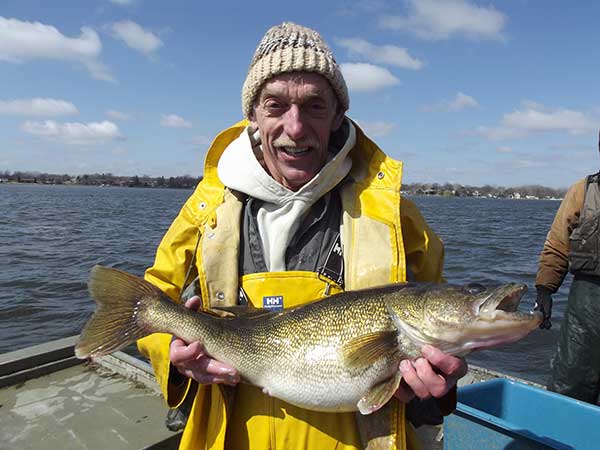 Fish biologist Jed Pearson with big walleye netted, tagged and released.Don’t panic if you find nets in Kosciusko County’s Winona Lake this month.
Fish biologist Jed Pearson with big walleye netted, tagged and released.Don’t panic if you find nets in Kosciusko County’s Winona Lake this month.
They were put there as part of an Indiana DNR study to learn more about the lake’s pike and walleye population.
Fisheries biologists will set six traps daily at various near-shore locations in the 562-acre natural lake at Warsaw this month.
Each pike and walleye captured will be measured, marked with a fin-clip, and then released.
By marking the fish, biologists can estimate the number of both species in the lake through a creel study this summer.
“We know Winona Lake had a pretty good pike population in the past, but we don’t know how many pike are there now, how big they are, or how many are caught by anglers,” said Steve Donabauer, DNR research biologist, in a press release.
Biologists will use the same trap nets to capture walleye and evaluate the population.
The DNR has stocked several thousand 6- to 8-inch walleye fingerlings in Winona annually since 2001. Although walleye survival has been good, biologists don’t have a handle on the number and size of adult walleyes.
Once the trapping is completed, a creel clerk will be work the lake this summer to count fishermen and examine their catch. The data will then be used to estimate total fishing effort and harvest.
The Winona pike project is part of a region-wide study. The number and size of pike in Indiana natural lakes are indicators of the quality of fish habitat.
“Pike do best in moderately clear, cool-water lakes with ample vegetation,” Donabauer said. “Where pike habitat declines due to manmade changes within and around a lake, the number of large, trophy-size, pike often declines as well.”
Pike are predator fish that typically hide in dense plant beds and ambush prey and help control gizzard shad and other forage fish species. Reproduction, however, can vary from year to year and lake to lake, depending on weather and habitat conditions. Loss of adjacent wetlands and natural shoreline areas can be especially harmful to pike reproduction.
The state record northern pike was caught in 1992 at Clear Lake in Steuben County and weighed 30 pounds, 2 ounces.
The DNR will also conduct a general population survey in June to check the number and sizes of all fish in the lake.


